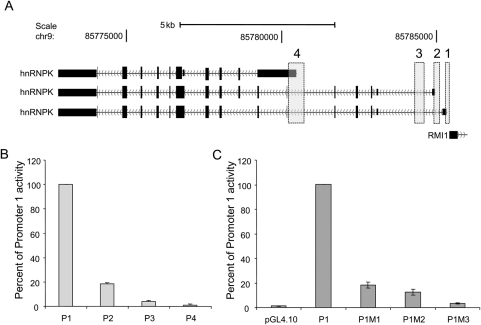Figure 1.
Graphical localization of HNRNPK promoters and their activity in HeLa cells. (A) Information from the annotated sequence databases GenBank and dbEST was analysed by computational tools, permitting the identification of four potential HNRNPK promoters. Localization of potential promoters sequences (vertical bars) are superimposed on three HNRNPK mRNA transcripts derived from the UCSC browser (hg18 genome assembly) http://genome.ucsc.edu (chr9:85772500-85786000). (B) HeLa cells were transiently transfected with constructs of four human HNRNPK promoters (P1, Promoter 1, containing the TCTCGCGAGA motif; P2, Promoter 2; P3, Promoter 3; P4, Promoter 4) fused to a luciferase reporter gene (pGL4.10) and cotransfected with the phrl-CMV plasmid encoding the Renilla luciferase gene as an internal control. (C) HeLa cells were transfected with mutated forms of the HNRNPK promoter 1 (P1M1, single mutation; P1M2, double mutation; P1M3, triple mutation; pGL4.10, null plasmid). Luciferase activities were measured 24 h after transfection. Mean firefly luciferase activities were normalized to Renilla luciferase activities measured for different promoter reporter plasmids. Data are expressed as a percentage of promoter fragment 1 activity, and represent the mean ± standard deviation of three independent experiments.

